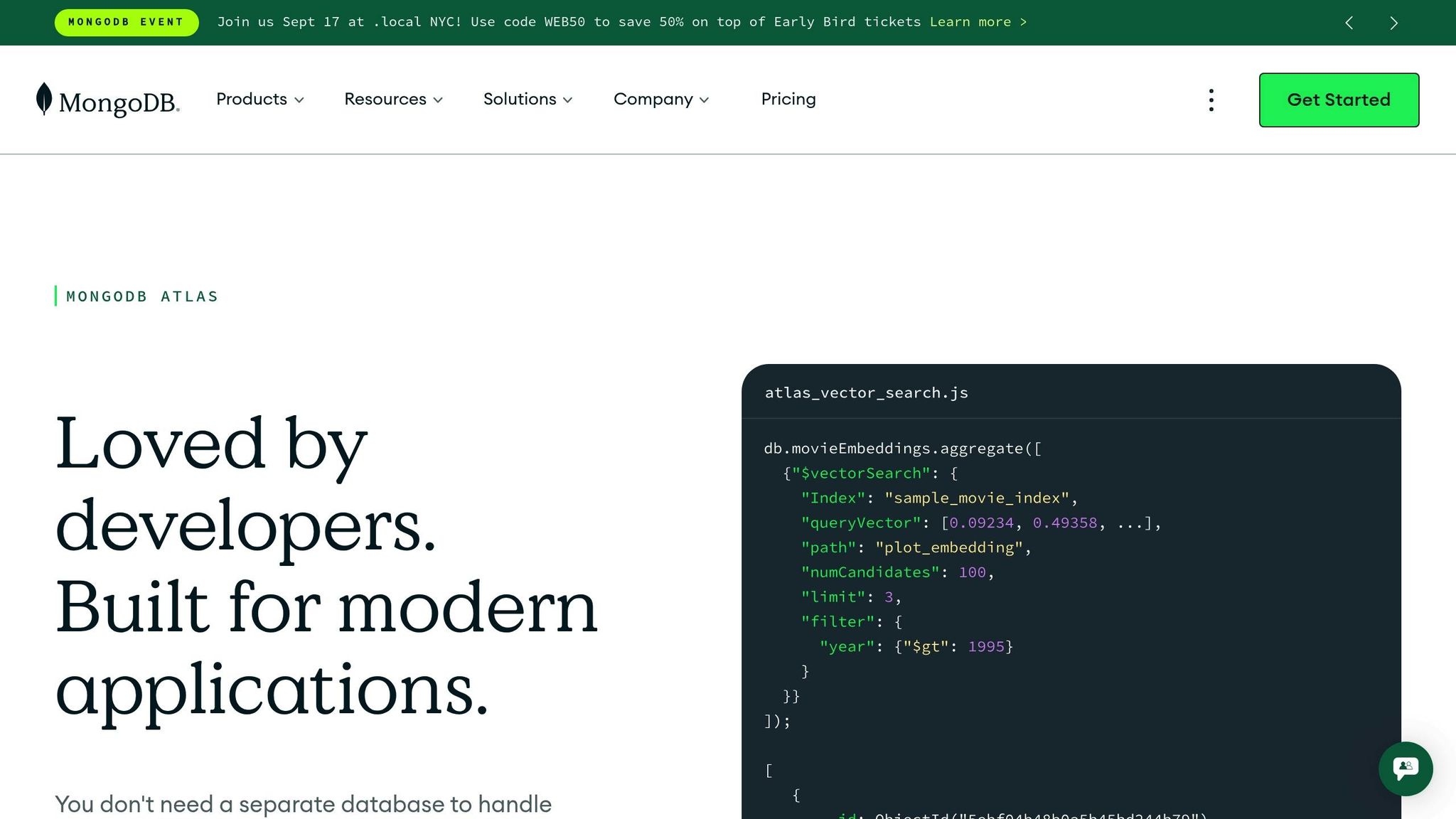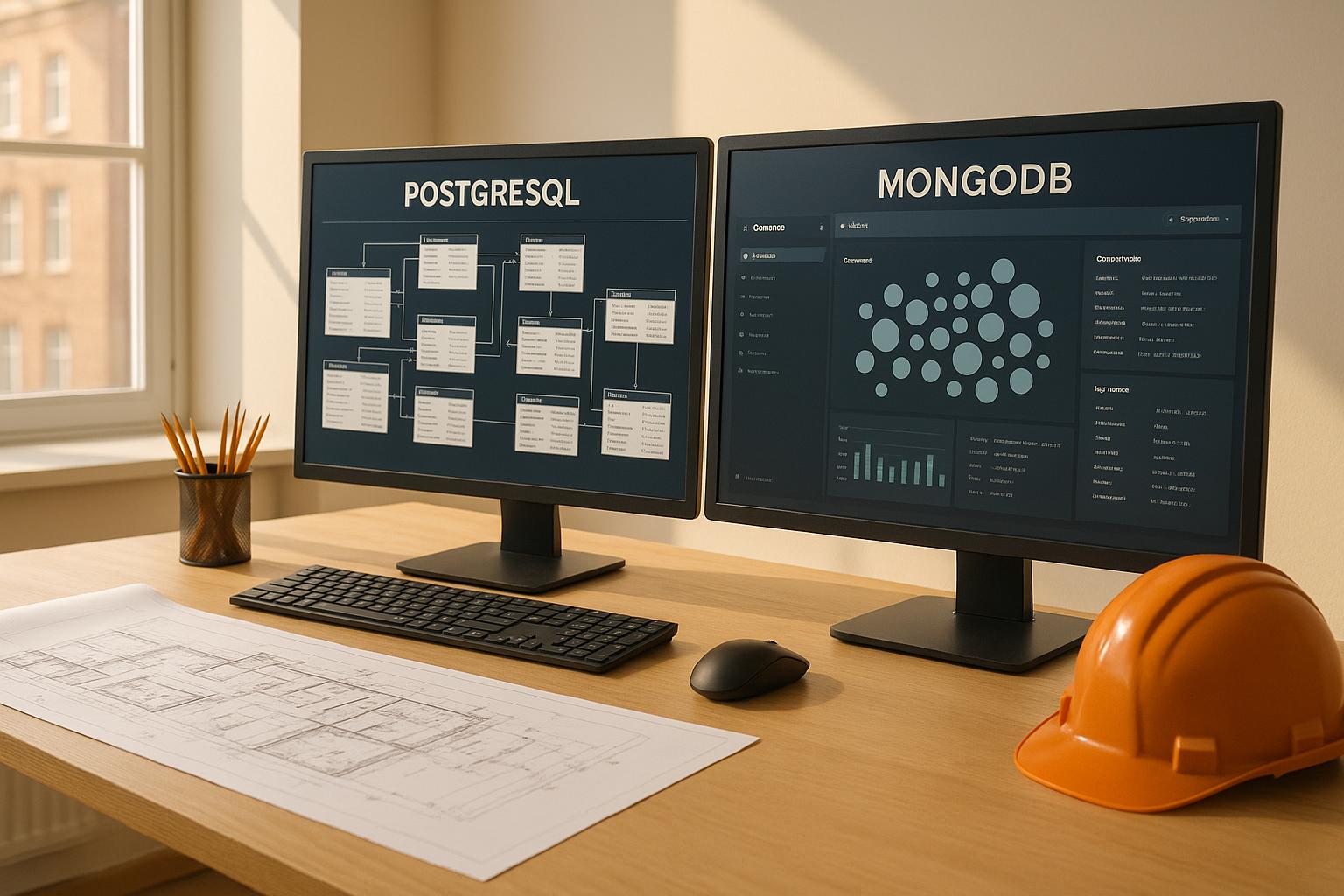When building construction software, your database choice is critical. PostgreSQL and MongoDB are two popular options, each excelling in different areas:
- PostgreSQL: Best for structured, consistent data like budgets, schedules, and compliance records. Its relational model ensures data accuracy and supports complex queries, making it ideal for financial tracking and reporting.
- MongoDB: Great for unstructured, dynamic data like site photos, field reports, and evolving workflows. Its flexible document model handles diverse data types without requiring strict schemas, making it suitable for real-time updates and collaboration.
Quick Comparison
| Feature | PostgreSQL | MongoDB |
|---|---|---|
| Data Model | Relational (tables, fixed schemas) | Document-based (flexible structure) |
| Schema Changes | Requires downtime and migrations | Dynamic, no downtime needed |
| Data Consistency | Strong (ACID compliance) | Eventual, configurable options |
| Scalability | Vertical scaling, read replicas | Horizontal scaling, sharding |
| Best Use Case | Structured workflows, reporting | Unstructured data, real-time updates |
If your software focuses on structured data and strict consistency, PostgreSQL is the better fit. For handling varied data types and real-time collaboration, MongoDB is the way to go. Some teams even combine both to leverage their strengths.
Choosing the Right Database: MongoDB vs PostgreSQL for Your Project (Developer Guide)

PostgreSQL: Features and Use Cases for Construction Software
When it comes to construction software, reliability is not just a nice-to-have – it’s essential. A single data error can snowball into costly delays or even safety concerns. That’s where PostgreSQL shines. Its solid architecture ensures the dependability construction teams need to keep projects on track.
As an open-source database, PostgreSQL boasts a rich ecosystem of extensions tailored for enterprise-level needs. Its reputation for handling mission-critical tasks makes it a go-to choice for construction firms that can’t afford downtime during active projects.
Let’s break down how PostgreSQL’s core strengths, like its relational model and transaction management, align perfectly with the demands of construction software.
PostgreSQL’s Relational Model and ACID Compliance
Construction projects are inherently structured, with clear hierarchies, roles, and workflows. PostgreSQL’s relational model mirrors this structure, making it ideal for managing project hierarchies, contractor relationships, and approval workflows. This ensures data consistency across all interconnected records.
ACID compliance plays a key role when multiple team members are simultaneously updating project data. For instance, imagine a project manager adjusting a budget while an accountant processes invoices for the same project. PostgreSQL ensures that either both operations succeed or neither does, preventing data corruption that could lead to financial errors.
The database also offers transaction isolation levels, giving developers control over how concurrent operations interact. For example, financial transactions might require strict consistency, while progress updates or document uploads can allow more flexibility. This balance optimizes performance without compromising data integrity.
Additionally, referential integrity ensures that related records remain consistent, reducing the risk of orphaned data that could disrupt complex workflows.
PostgreSQL Features for Construction Applications
PostgreSQL includes features that address many of the unique challenges faced by construction software.
- Advanced data types: With native support for JSON, developers can store flexible project metadata alongside structured data. This reduces the complexity of application code while keeping business rules consistently enforced.
- Geometric data types: These are perfect for storing site boundaries, building layouts, or equipment locations. PostgreSQL handles points, lines, and polygons natively, making it easy to integrate with GIS tools essential for site planning and logistics.
- Full-text search: Locating specific information across thousands of documents, specifications, or change orders becomes a breeze. PostgreSQL indexes document content, enabling teams to find what they need in seconds instead of hours.
The database’s extension ecosystem further enhances its capabilities. For instance, the PostGIS extension turns PostgreSQL into a spatial database, enabling construction firms to analyze delivery routes, assess site accessibility, or even process drone survey data.
For reporting, materialized views are a game-changer. These allow pre-calculated results for complex queries, such as cost summaries or progress reports, to be refreshed on a schedule. This approach saves time and ensures managers have up-to-date information without overloading the database.
PostgreSQL Scalability, Security, and Compliance
As construction companies grow, their software needs to scale seamlessly. PostgreSQL supports horizontal scaling through logical replication and partitioning, allowing data to be distributed across multiple servers while maintaining performance and consistency.
Read replicas let operational users and reporting tools access data without slowing down the primary database. On the security side, row-level security provides granular control over who can access specific data, which is crucial for managing sensitive workflows.
For compliance and auditing, PostgreSQL offers audit logging capabilities that track every data change, complete with timestamps and user details. This is invaluable for meeting regulatory requirements or resolving disputes.
Data protection is another priority. PostgreSQL’s backup and recovery options include point-in-time recovery, enabling companies to restore data to a specific moment if discrepancies arise. Hot backups ensure that these operations don’t disrupt ongoing work.
Finally, PostgreSQL prioritizes data security with SSL encryption and certificate-based authentication, safeguarding sensitive information like financial records and project bids. These measures help maintain client trust and meet contractual obligations.
Even under heavy usage, PostgreSQL’s connection pooling and query optimization ensure consistent performance. These features make it a standout choice for construction software, even before stacking it up against alternatives like MongoDB.
MongoDB: Features and Use Cases for Construction Software
While PostgreSQL is great for managing structured project data, MongoDB shines when handling the unstructured and semi-structured data often found in construction projects. Think of field photos, inspection reports, and change orders – these don’t always follow a neat, consistent format. MongoDB’s approach to data management makes it a strong choice for tackling this kind of variety.
At the core of MongoDB is its document-based NoSQL model, which stores data in flexible, JSON-like documents rather than in rigid tables. This flexibility allows construction software to adapt quickly to evolving needs without the hassle of major restructuring.
Another standout feature is MongoDB’s horizontal scaling capabilities, which make it easy to handle sudden increases in data volume. This is especially useful during peak construction seasons or when managing multiple large-scale projects. Let’s take a closer look at how MongoDB’s schema design supports these needs.
MongoDB’s Document Model and Schema Flexibility
Relational databases rely on predefined schemas, but construction data rarely fits into neat, predictable patterns. A single project might involve dozens of different document types, each with unique fields and structures. MongoDB’s schema flexibility is built to handle this kind of diversity.
Take Request for Information (RFI) documents, for example. One RFI might include architectural drawings, photos, and technical specs, while another might just contain text clarifications. MongoDB allows each document to maintain its unique structure, avoiding the need for complex table joins or placeholder fields that relational databases often require.
The database also supports nested documents, which are perfect for managing complex construction hierarchies. For instance, a single project document can include embedded details about sub-projects, phases, tasks, and resources. This structure simplifies queries and eliminates the headaches associated with multi-table joins.
When construction firms expand their services or adopt new workflows, dynamic schema evolution becomes a game-changer. MongoDB can seamlessly add new fields to existing documents without requiring downtime or migration scripts, allowing teams to adapt without interruptions.
MongoDB for Real-Time Collaboration and Scaling
Construction teams often operate across different locations and time zones, and MongoDB’s horizontal scaling architecture ensures smooth collaboration by distributing data across multiple servers. This setup keeps performance steady, no matter the team size or geographic spread.
Sharding is another useful feature, allowing data to be partitioned logically – perhaps by project location, contractor, or project phase. This ensures teams can quickly access the data they need without slowing down the system for others.
For reliability, MongoDB’s replica sets provide automatic failover and data redundancy, which is critical for construction firms that can’t afford downtime during active projects. If one server fails, another takes over immediately, minimizing disruptions.
MongoDB also supports real-time analytics through its aggregation pipeline, which processes large datasets efficiently. This enables construction managers to track project metrics like budget usage, timeline progress, and resource allocation in real time via dashboards.
Another standout feature is change streams, which notify teams instantly when project data updates. Whether it’s a permit approval, a material delivery update, or a safety incident report, these notifications keep everyone on the same page without the need for constant check-ins.
Finally, MongoDB’s flexible indexing adjusts to changing query patterns as projects evolve. For example, indexes on fields like project status or contractor name can be updated to meet new reporting needs. Combined with its real-time performance, MongoDB also excels in cloud integration and security.
MongoDB Cloud Integration and Security
With construction projects often spread across multiple sites, cloud deployment has become essential. MongoDB’s native cloud integration works seamlessly with platforms like AWS, Google Cloud, and Microsoft Azure, ensuring data is both scalable and accessible.
MongoDB Atlas takes care of backups, monitoring, and security patches automatically, reducing the workload for IT teams.
Role-based access control is particularly useful for construction’s complex permission needs. For instance, project managers might need full access to their projects, while subcontractors only see specific parts. MongoDB’s field-level security ensures sensitive information – like bid amounts or proprietary specs – remains protected.
To safeguard data further, MongoDB offers encryption at rest and in transit, which protects sensitive project details throughout their lifecycle. This is especially important for securing competitive bid information and other critical data.
For compliance and dispute resolution, audit logging tracks every database operation, creating a detailed record of who accessed what and when.
Finally, MongoDB’s multi-cloud deployment options allow construction firms to meet geographic or regulatory requirements. Data can be stored in specific regions while remaining accessible to global teams, making it a versatile choice for modern construction software. By aligning these features with the unique challenges of the construction industry, startups can identify the best database solution for their needs.
sbb-itb-51b9a02
PostgreSQL vs MongoDB: Side-by-Side Comparison
Choosing between PostgreSQL and MongoDB boils down to matching the database’s strengths with the specific challenges your construction teams face daily. Each database shines in different areas, and understanding these differences is key to making a choice that supports your software’s long-term goals.
Feature and Performance Comparison Table
To better understand how PostgreSQL and MongoDB stack up, let’s compare their core features side by side:
| Feature | PostgreSQL | MongoDB |
|---|---|---|
| Data Model | Relational tables with fixed schemas | Flexible document-based structure |
| Schema Changes | Requires migration scripts and downtime | Dynamic schema evolution without downtime |
| Data Consistency | ACID compliance with strong consistency | Eventual consistency with configurable options |
| Scalability | Vertical scaling with read replicas | Horizontal scaling with automatic sharding |
| Query Language | Standard SQL with advanced features | MongoDB Query Language (MQL) |
| Real-time Features | Basic real-time support | Built-in change streams and real-time updates |
| Complex Relationships | Excellent with JOINs and foreign keys | Requires document embedding or references |
| Unstructured Data | JSON support but table-centric | Native handling of diverse documents |
| Cloud Integration | Available but requires setup | Native cloud services with MongoDB Atlas |
| Learning Curve | Familiar SQL for most developers | New query syntax and concepts |
Database Selection by Construction Software Use Case
Building on these technical differences, let’s explore how each database aligns with common construction software needs.
PostgreSQL is ideal for software that manages structured project workflows with consistent, predictable data patterns. Its ACID compliance ensures data integrity, which is critical for tasks like permit tracking, budget management, and resource allocation. PostgreSQL’s ability to handle complex relationships through JOINs and foreign keys makes it an excellent choice for managing intricate project hierarchies, ensuring accurate tracking of timelines, budgets, and dependencies.
For financial management and reporting, PostgreSQL stands out. Whether you’re tracking costs, maintaining audit trails, or generating detailed reports, PostgreSQL’s robust query capabilities make it perfect for creating dashboards that pull together data from multiple sources.
MongoDB excels when managing diverse, unstructured field data. Its flexible document-based structure is particularly useful for platforms serving various contractors, each with unique workflows and data needs. This adaptability allows construction management software to easily handle field reports, site photos, and other dynamic content without the constraints of rigid schemas.
In scenarios requiring real-time collaboration, MongoDB’s built-in change streams and sharding make it a strong contender. For example, when teams need instant updates on project changes, material deliveries, or safety alerts, MongoDB ensures these updates are distributed quickly, even during data spikes or across geographically dispersed teams. Its horizontal scaling capabilities make it well-suited for managing seasonal usage patterns or large-scale projects.
A hybrid approach can sometimes offer the best of both worlds. Some teams use PostgreSQL for core data like budgets, schedules, and contracts, while relying on MongoDB for dynamic content such as field reports and communication logs. This strategy allows you to leverage the strengths of both databases while maintaining a cohesive system.
Ultimately, the choice depends on your primary needs. If your construction software prioritizes data consistency, complex reporting, and structured workflows, PostgreSQL is the way to go. On the other hand, if flexibility, real-time updates, and managing diverse data types are key, MongoDB provides the versatility to meet those demands. Aligning your database choice with your project’s specific requirements ensures your software delivers the best results.
Database Selection Guide for Construction Startups
Choosing the right database for your construction startup isn’t just about technology – it’s a decision that can shape your software’s performance, development timeline, and scalability. A poor choice could lead to expensive migrations or performance issues down the line. Let’s break down the key factors to consider.
Key Database Selection Factors
The database you choose should align with your data needs and overall strategy. For structured data like budgets or timelines, PostgreSQL provides the consistency you’ll need. On the other hand, if your platform handles varied data types – like job site photos, contractor workflows, or shifting project documentation – MongoDB’s flexible document structure can adapt to these evolving requirements.
Your team’s technical expertise also plays a role. If your developers are already familiar with SQL, PostgreSQL will feel natural. MongoDB, with its document-based design, might require additional training, which could slow development – especially if you’re on a tight schedule.
Budget is another important factor. PostgreSQL is open-source and avoids licensing fees, but you’ll need to account for hosting, maintenance, and managed service costs. MongoDB’s costs can vary depending on your scaling needs, so weigh these against your startup’s financial plan.
Scalability is critical from day one. PostgreSQL is ideal for vertical scaling, making it great for steady growth. However, if you anticipate rapid user growth or seasonal spikes, MongoDB’s horizontal scaling capabilities may be a better fit. Consider how much concurrent usage your system will need to handle when making your decision.
Integration requirements are also worth noting. If your software needs to connect with existing SQL-based systems like accounting tools, ERP platforms, or government databases, PostgreSQL’s compatibility gives it an edge. MongoDB’s document format might require additional transformation layers, which can complicate integrations.
Finally, think about real-time collaboration. Construction teams increasingly expect instant updates when plans change. For features like live project updates or collaborative document editing, MongoDB’s built-in change streams can deliver the real-time functionality modern teams demand.
How AlterSquare Helps with Database Selection and Architecture

Navigating these decisions can be overwhelming, but expert guidance can make all the difference. AlterSquare offers tech stack consultation services tailored to construction startups, helping you evaluate your needs and match them with the strengths of each database.
Their 90-day MVP program integrates database selection into early discovery and rapid prototyping. By testing performance in real-world scenarios, AlterSquare minimizes the risk of choosing a database that won’t meet your needs.
If you’re worried about outgrowing your initial database choice, AlterSquare’s application modernization services can help. They manage migrations and architecture updates with minimal disruption, ensuring your software evolves without major roadblocks.
Through their engineering-as-a-service model, AlterSquare provides more than just advice – they offer a skilled team that understands how database decisions impact your software’s overall functionality. Whether it’s integrating with popular construction APIs or optimizing queries for large datasets, their expertise ensures your database choice supports both your current needs and long-term growth.
With experience in technologies like Node.js, GoLang, and Vue.js, AlterSquare ensures your database fits seamlessly into your tech stack. Their integrated approach helps avoid common mistakes and sets your construction startup up for success.
Conclusion: Making the Right Database Choice for Construction Software
Choosing the right database is a cornerstone for ensuring construction software can handle the complex, real-time demands of the industry. The database you select will significantly influence how your software performs and scales over time.
For structured data – think budgets, schedules, or compliance records – PostgreSQL shines. It offers ACID compliance, making it a reliable choice for managing critical financial transactions and integrating seamlessly with other systems.
On the other hand, if your projects involve varied and constantly changing data, such as project photos or evolving workflows, MongoDB provides the flexibility you need. Its schema-less design allows it to adapt without the overhead of costly schema updates.
Your decision should align with your technical needs and the unique challenges of your projects. Consider your team’s expertise – choosing a database that matches their skills can streamline development and reduce errors. Don’t overlook long-term costs, including hosting, scaling, and potential migration. These factors can have a significant impact on your project’s sustainability.
To make the best choice, prototype with real-world construction data. Test performance under realistic workloads and evaluate how well each option integrates with your existing tools and workflows. By carefully balancing your data requirements, scalability goals, and team capabilities, you’ll build a database foundation that supports both your immediate objectives and future growth.
FAQs
What are the benefits of using both PostgreSQL and MongoDB together in construction software?
Combining PostgreSQL and MongoDB in construction software brings together the strengths of both databases to tackle a variety of tasks. PostgreSQL shines when it comes to managing structured data. It ensures precision and reliability, making it perfect for handling financial records, project schedules, and detailed reports. Meanwhile, MongoDB is built to handle unstructured or semi-structured data effortlessly. This makes it a go-to choice for managing real-time updates, workflows, and multimedia files like images and videos.
By pairing these two databases, you create a system that’s not only efficient but also adaptable to the wide-ranging demands of construction projects. Each database handles what it does best, resulting in a solution that’s both powerful and versatile, meeting the unique challenges of the construction industry head-on.
How does choosing PostgreSQL or MongoDB affect the scalability and performance of construction software over time?
The database you select – PostgreSQL or MongoDB – can significantly influence how well your construction software handles growth and performance over time.
MongoDB shines when it comes to scalability. It can automatically spread data across multiple servers, making it a solid choice for managing large volumes of unstructured data, like project files or real-time collaboration updates. This capability becomes especially valuable as your software expands. On the flip side, PostgreSQL is built for structured data and complex queries. It uses vertical scaling (adding resources to a single server), which often delivers superior performance for transactional tasks that demand high data accuracy and integrity.
If your focus is on flexibility and rapid expansion, MongoDB could be the better option. But for use cases that require strong data relationships and detailed reporting, PostgreSQL is likely the smarter pick.
What should construction startups consider when choosing between PostgreSQL and MongoDB for their database?
When choosing between PostgreSQL and MongoDB, construction startups should consider their unique data requirements and future growth plans. For software that deals with intricate relationships, demands strict data consistency, or requires advanced querying capabilities, PostgreSQL‘s relational model and ACID compliance offer a strong foundation. Its structured design works well for managing workflows and project data with clearly defined relationships.
On the flip side, if your data is unstructured or semi-structured, or if you need schema flexibility and horizontal scalability, MongoDB might be the better option. It supports faster development cycles and is particularly effective for real-time collaboration tools or managing large and growing datasets.
The choice ultimately hinges on your software’s complexity, the nature of your data, and your scalability objectives. Take time to assess these aspects to select the database that best suits your long-term goals.
Related Blog Posts
- Mobile-First Construction: Bringing Field Operations into the Digital Age
- Cloud vs. On-Premise: The Right Architecture for Construction Software Startups
- Responsive Design for Construction Sites: Making Web Apps Work in the Field
- How Small AEC Firms Can Leverage Cloud Technology to Win Enterprise Projects









Leave a Reply